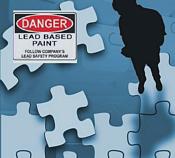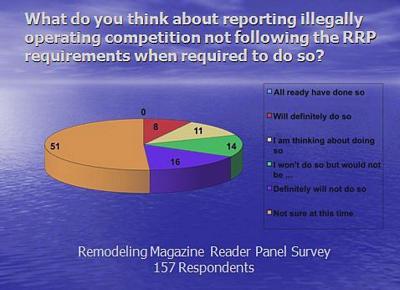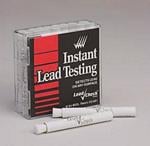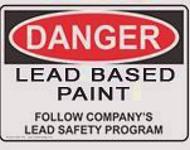Be Heard: How Has The RRP Rule Affected Your Business?
Your help is requested

I am writing to you today asking for help. And, at the same time, I am hoping to help you.
 The recent RRP rule requires contractors to follow certain lead-safe work practices to protect homeowners, their families and the workers who perform work where lead paint is or might be present. The rule also requires training of workers to be sure they know how to do the work, protect themselves and stay in compliance with the rule. Lead poisoning is a real issue. Protecting people from the dangers of lead is the right thing to do. Although we may all have our own opinions about the actual rule itself, as an industry and as professionals, we must do what is right.
The recent RRP rule requires contractors to follow certain lead-safe work practices to protect homeowners, their families and the workers who perform work where lead paint is or might be present. The rule also requires training of workers to be sure they know how to do the work, protect themselves and stay in compliance with the rule. Lead poisoning is a real issue. Protecting people from the dangers of lead is the right thing to do. Although we may all have our own opinions about the actual rule itself, as an industry and as professionals, we must do what is right.
In my efforts to help our industry work with this rule and the EPA, I have been a strong voice calling for compliance with the current rule as it stands. I have also been a strong voice in regards to questioning the practicality of the rule as well as the EPA’s apparent lack of interest in enforcement.
 Many businesses, ranging from remodelers, subcontractors, manufacturers, distributors, vendors, trainers and even trade associations have contacted me to express their disappointment with EPA’s handling of this rule since it took effect on April 22, 2010. Although EPA claims to have done extensive outreach to consumers and the regulated community, the results of their efforts have proven to be ineffective. Enforcement of the rule so far has been almost non-existent, particularly in light of the number of non-compliant businesses still doing the work in ways that are definitely poisoning our children, their families and those workers who perform renovations where lead is present. The EPA’s June announcement regarding their decision to delay enforcement of the training and firm certification requirements was interpreted by many renovators as a delay of the whole rule, not just the fines for such violations. As a result, many businesses trying to support renovators in complying with the rule have reported that sales have dropped to the point where they must consider shutting down. I could go on with my list but I am probably preaching to the choir.
Many businesses, ranging from remodelers, subcontractors, manufacturers, distributors, vendors, trainers and even trade associations have contacted me to express their disappointment with EPA’s handling of this rule since it took effect on April 22, 2010. Although EPA claims to have done extensive outreach to consumers and the regulated community, the results of their efforts have proven to be ineffective. Enforcement of the rule so far has been almost non-existent, particularly in light of the number of non-compliant businesses still doing the work in ways that are definitely poisoning our children, their families and those workers who perform renovations where lead is present. The EPA’s June announcement regarding their decision to delay enforcement of the training and firm certification requirements was interpreted by many renovators as a delay of the whole rule, not just the fines for such violations. As a result, many businesses trying to support renovators in complying with the rule have reported that sales have dropped to the point where they must consider shutting down. I could go on with my list but I am probably preaching to the choir.
I want to help you and others who are trying to comply with this rule. Here’s how you can help me. First, send me your thoughts regarding how this rule is affecting you, your business, your employees, the economy, our industry and any other areas of importance. My plan is to assemble the information I receive and then share it. Because of the failure of the EPA to raise public awareness regarding the dangers of lead, policy makers and influencers simply aren’t “getting it.” Therefore, I intend to do my best to publicize the data in a way that attracts the attention of those who have the ability to force our government to stand behind their commitment to protect our citizens from the dangers of lead.
 Second, if you have suggestions, contacts and or the means to assist me in distributing this information to those who can help us with this important issue, please let me know. Anyone is welcome to leave comments here at the end of this blog. However, I would prefer that you e-mail me your thoughts in letter-like form and that you include your complete contact information as well as your permission to use and distribute what you send me. I will not redistribute information from anonymous parties.
Second, if you have suggestions, contacts and or the means to assist me in distributing this information to those who can help us with this important issue, please let me know. Anyone is welcome to leave comments here at the end of this blog. However, I would prefer that you e-mail me your thoughts in letter-like form and that you include your complete contact information as well as your permission to use and distribute what you send me. I will not redistribute information from anonymous parties.
I thank you in advance for your consideration and your help. Please feel free to forward this information to others who might be able to help and or need help regarding this serious concern.
Shawn McCadden
Remodeling Industry Specialist

 Looking for accurate information about the EPA RRP rule?
Looking for accurate information about the EPA RRP rule?  Deleading under the MA Lead Law requires the removal or covering of
Deleading under the MA Lead Law requires the removal or covering of  At a recent
At a recent 
 Renovators doing RRP work definitely need to know the difference between renovations and abatement. Unless specifically licenced to do so, renovators are not allowed to do abatement work. Renovators would be wise to make sure property owners know the difference as well. Employees should also be clear on the difference between renovations vs abatement, so as not to misrepresent the work they are doing when discussing a remodeling project with clients and prospects.
Renovators doing RRP work definitely need to know the difference between renovations and abatement. Unless specifically licenced to do so, renovators are not allowed to do abatement work. Renovators would be wise to make sure property owners know the difference as well. Employees should also be clear on the difference between renovations vs abatement, so as not to misrepresent the work they are doing when discussing a remodeling project with clients and prospects. A project resulting in the permanent removal of lead paint hazards, conducted by a company who, through its name or promotional literature, represents, or advertises to be in the business of performing lead paint activities.
A project resulting in the permanent removal of lead paint hazards, conducted by a company who, through its name or promotional literature, represents, or advertises to be in the business of performing lead paint activities. Abatements are not covered by the RRP rule.
Abatements are not covered by the RRP rule. Although every “legal” remodeler I have spoken to expresses concerns about illegal competition doing their work in violation of the RRP rule, these remodelers are split about whether to report their illegal completion or not. At the Opening Session I presented on Thursday morning at the Remodeling Show I offered my point of view on this. I suggested that illegal contractors and the home owners who hire them are stealing business and money away from legal remodelers and their employees. I gave the example that if you or I steal a TV from someone and get caught, we must return the TV and suffer any consequences. If an illegal contractor or home owner steals a deck job from a legal contractor little or nothing is ever done and the home owner gets to keep the deck. How long will our industry and the trade associations that represent us tolerate this? Just like with illegal immigration, because our government does not enforce existing rules and laws on a consistent basis, illegal contractors operate with little fear of being caught and even if caught, have little fear of any consequences.
Although every “legal” remodeler I have spoken to expresses concerns about illegal competition doing their work in violation of the RRP rule, these remodelers are split about whether to report their illegal completion or not. At the Opening Session I presented on Thursday morning at the Remodeling Show I offered my point of view on this. I suggested that illegal contractors and the home owners who hire them are stealing business and money away from legal remodelers and their employees. I gave the example that if you or I steal a TV from someone and get caught, we must return the TV and suffer any consequences. If an illegal contractor or home owner steals a deck job from a legal contractor little or nothing is ever done and the home owner gets to keep the deck. How long will our industry and the trade associations that represent us tolerate this? Just like with illegal immigration, because our government does not enforce existing rules and laws on a consistent basis, illegal contractors operate with little fear of being caught and even if caught, have little fear of any consequences.
 As we all wait to see what happens with the economy and how long a real recovery will take, I predict that their ability to pay their mortgage and put food on the family table will persuade many remodeling business owners to take action and defend their ability to run honest businesses.
As we all wait to see what happens with the economy and how long a real recovery will take, I predict that their ability to pay their mortgage and put food on the family table will persuade many remodeling business owners to take action and defend their ability to run honest businesses.
 The
The  One way to think about this might be to relate it to eating fish. The government often says that if you fish in certain bodies of polluted water, you can safely eat up to so many of the fish you catch without any health concerns. If the government says you can eat up to 3 fish a year, how safe would you feel eating even one fish? Using this analogy, how safe might the owner feel having renovations done if there is any lead present at all at their property?
One way to think about this might be to relate it to eating fish. The government often says that if you fish in certain bodies of polluted water, you can safely eat up to so many of the fish you catch without any health concerns. If the government says you can eat up to 3 fish a year, how safe would you feel eating even one fish? Using this analogy, how safe might the owner feel having renovations done if there is any lead present at all at their property? In a recent article about their efforts to address challenges for builders and remodelers due to the new EPA RRP rule, the National Association of Home Builders (NAHB) left out some critical information that causes their article to be very misleading to renovators and home owners unfamiliar with specific details about the RRP rule. In my opinion, the article also does a disservice to the manufacturer of
In a recent article about their efforts to address challenges for builders and remodelers due to the new EPA RRP rule, the National Association of Home Builders (NAHB) left out some critical information that causes their article to be very misleading to renovators and home owners unfamiliar with specific details about the RRP rule. In my opinion, the article also does a disservice to the manufacturer of  One way to think about this might be to relate it to eating fish. The government often says that if you fish in certain bodies of polluted water, you can safely eat up to so many of the fish you catch without any health concerns. If the government says you can eat up to 3 fish a year, how safe would you feel eating even one fish? Using this analogy, how safe might the home owner feel having renovations done without using lead-safe work practices if there is any lead at all present at their property? The choice should be theirs.
One way to think about this might be to relate it to eating fish. The government often says that if you fish in certain bodies of polluted water, you can safely eat up to so many of the fish you catch without any health concerns. If the government says you can eat up to 3 fish a year, how safe would you feel eating even one fish? Using this analogy, how safe might the home owner feel having renovations done without using lead-safe work practices if there is any lead at all present at their property? The choice should be theirs. Many remodelers have asked me about resources they can use to find out more about lead, lead poisoning and the EPA RRP rule. When I ask them why they are looking for this information two common reasons seem to rise to the top. First, they are looking to better educate themsleves about lead and lead poisoning so they can be better prepared to discuss the health risks of lead with their clients and prospects. Second, they are looking for resources to share with their prospects and clients, either as part of their marketing efforts or to add to their web sites.
Many remodelers have asked me about resources they can use to find out more about lead, lead poisoning and the EPA RRP rule. When I ask them why they are looking for this information two common reasons seem to rise to the top. First, they are looking to better educate themsleves about lead and lead poisoning so they can be better prepared to discuss the health risks of lead with their clients and prospects. Second, they are looking for resources to share with their prospects and clients, either as part of their marketing efforts or to add to their web sites. The EPA has created a "Lead-Safe Certified Firm" logo available for use by Certified Firms who perform work under the EPA RRP Rule. Adding this logo to company materials such as websites, brochures, invoices, e-mail signatures, business cards, truck signage, job signs, etc. may give a contractor or renovation firm an edge over other companies who have not yet become certified (or who are not yet advertising that they are certified). Using the logo can also help spread the word to homeowners about the EPA RRP requirements and the need to protect their families from the potential dangers of lead paint.
The EPA has created a "Lead-Safe Certified Firm" logo available for use by Certified Firms who perform work under the EPA RRP Rule. Adding this logo to company materials such as websites, brochures, invoices, e-mail signatures, business cards, truck signage, job signs, etc. may give a contractor or renovation firm an edge over other companies who have not yet become certified (or who are not yet advertising that they are certified). Using the logo can also help spread the word to homeowners about the EPA RRP requirements and the need to protect their families from the potential dangers of lead paint.

 According to the Q&A area of the EPA's web site, before you can offer or do work on pre-1978 homes, you must be a Certified Firm (
According to the Q&A area of the EPA's web site, before you can offer or do work on pre-1978 homes, you must be a Certified Firm ( NOTE: Rhode Island is one of many states and or tribal authorities that has been granted and or is seeking authorization by the EPA to administer the RRP program. The opt-out provision is/will not be allowed in RI. If you know of the status of the opt-out in RI and or other states, please contribute that information along with a source/link to confirm accuracy.
NOTE: Rhode Island is one of many states and or tribal authorities that has been granted and or is seeking authorization by the EPA to administer the RRP program. The opt-out provision is/will not be allowed in RI. If you know of the status of the opt-out in RI and or other states, please contribute that information along with a source/link to confirm accuracy. 


